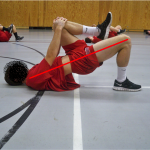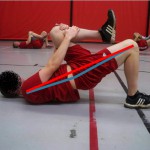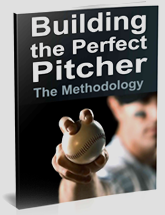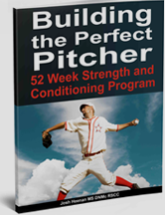Interview With Josh Heenan
(Written by Michael Wittner)
For more than seven years, Josh Heenan has worked in the field of sports training and medicine. He has a doctorate in Integrated Medicine and is currently Head Strength Coach and Doctor of Integrated Medicine at Moore Fitness and Physical Therapy in Southport, Connecticut. Prior to working at Moore, he was the Head Strength and Conditioning Coach for Sacred Heart University’s Baseball Program, a Division 1 baseball school. In addition, Josh has a master’s degree in Human Movement and Sports Psychology and bachelor’s in Exercise Science.
Josh currently trains athletes at numerous levels starting from high school and continuing through the professional level. He also has been a consultant to multiple organizations for sports training and rehabilitation. In an exclusive interview, Josh described his influences and philosophies in training, medicine, and rehabilitation.
Mike: What made you interested in the field of strength and conditioning, physical therapy, and medicine?
Josh: From when I was very little I always remember my father exercising. He was in the sports medicine field during his early 20′s working with the Celtics and Patriots. From there he became a police officer and always said his job was a “full-contact sport” and prepared for the worst so he would always come home in one piece. When I was about 14 I fell in love with the process of training and how the hard work allowed me to stay ahead of my competition.
M: Were you considering other majors at the time or were you only interested in strength and conditioning, physical therapy, and medicine?
J: If I did not have option to play baseball in college, I would have likely tried to become a Navy SEAL. I love the mental side of training (which they have come close to mastering) and pushing my body to the limits was enticing—not to mention being our first line of defense for the USA.
M: After entering the field, how has it made an impact on your life?
J: Many people say they love their jobs, but I doubt many love it as much as I do. I have the best clients in the world. I wake up everyday excited to help motivated people (athletes and non-athletes) pursue their goals. I was never a reader growing up (this was evident in probably the worst SAT English/Math split in the history of the exam), but once I entered college I literally read anything I could get my hands on in the field. To this day, I read research whenever I have a free minute and go to bed reading research. We have come so far in the fields of performance enhancement, therapy, and medicine—yet we are still barely scratching the surface.
M: What is your philosophy on physical training and how is it different from other trainers?
J: Everyone moves differently due to posture, orthopedics, injuries, and other limitations; not to mention each has a different health history and short/long term goals. Posture dictates function. In turn, each person should be treated as an individual and look for relative improvements.

M: In your experience, what are the most limiting and most common problems that your athletes have?
J: Most young athletes don’t move very well and are incredibly weak. Everyone wants the magic formula to run fast, throw hard, and move well. It’s really simple, learn to move well and get as strong as possible in movements that relate to your ultimate goal(s). Strength is corrective and will allow you to express your potential for speed and health.
M: How do these problems affect the athlete’s performance in training and playing their sport?
J: Strength and movement limitations are the reasons we get injured (except for contact injuries). My number one goal as a coach/therapist is to keep our athletes healthy and on the field.
M: Is there a certain way that one should train during the season vs. the off-season?
J: These are generalities, but in-season we tend to use less total volume of work with a bit higher intensity and off-season we use more volume of work.
M: Which is more important strength or agility, or are both needed in order to keep each other balanced? Why?
J: Strength is the foundation for speed and agility. With greater strength, we have a higher ability to express force output through agility, power, and speed. Strength elevates all athletic qualities.
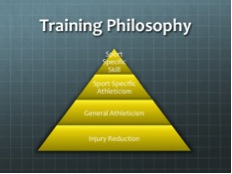
M: Lastly, how would you define eating properly? Is it different for every person? Why?
J: Eating “properly” is determined by someone’s goals. If you want to be the next Kobayashi, then eating 50 hot dogs a day may not be the worst thing for your goals. Everyone defines healthy and fit in a different way– you would have to define it before I can advise on how to best attain those goals.

M: Thank you very much for your time. It was a very informative interview.
J: It was my pleasure!
Solving Volleyball Knee Pain
Competitive volleyball is a sport plagued with countless injuries. One of the most common injuries reported is jumper’s knee.
Jumper’s knee, patellar tendonitis or patellar femoral syndrome (PFS) are the common diagnosis for “general” front of the knee, pain. Knee pain in a jumping sport can be incredibly debilitating as in many cases it can take as long as months to fully recover.
When looking at patellar tendonitis for our athletes; the first area of concern is the ankle. Acute ankle injuries make up a majority of volleyball injuries(Bahr & Bahr, 1997). Injured ankles often lack the proper mobility, mainly in dorsiflexion (e.g. limited motion foot towards the shin). As you can see in the images below, poor ankle mobility can lead to poor landing mechanics and put more stress to the knee and can irritate any existing knee pathologies or create new ones.

ACL Drop Test- also a good test for patients with knee pain.
After clearing the ankle, we usually attack hip mobility and glute strength. Any tightness in the hip flexors are going to limit the strength of our glutes, which often leads to poor movement at the knees and limited jumping power, both major qualities needed for successful volleyball play. A basic strengthening and test exercise for glute strength is a single leg bridge. We look for knees, hips and shoulders to be in one straight line.
Addressing soft tissue of the quads and glutes through foam rolling and manual therapy expedite the recovery time. Often with aggressive treatment we can see jumping athletes back on the court the same week.
Assessing overall movement followed by breaking down each joints function helps us paint a picture of why the knee is the culprit in pain; as it is usually not the dysfunctional area driving the pain.
Related Articles:
Ankle Instability: Rest vs. Early Mobilization by Craig Leibenson
Hamstring Dominance by Brijesh Patel
References
Bahr, R., & Bahr, I. A. (1997). Incidence of acute volleyball injuries: a prospective cohort study of injury mechanisms and risk factors. Scandinavian Journal of Medicine & Science in Sports, 7(3), 166–171. doi:10.1111/j.1600-0838.1997.tb00134.x
Optimizing Recovery From Injury
Recovering from an injury or surgery has numerous variables that the injured person can manipulate to promote healing and faster recovery.
Many of you reading this likely know that I just underwent a femoroacetabular impingement (FAI) surgery. I am currently writing this post from hospital bed at 3 am to keep my sanity intact while waiting for the nurses to check my vitals every few hours.
When prepping clients for a surgery or athletes recovering from an injury I always try to stress what they can change NOT what is out of their control. Some of these variables include diet, supplementation, sleep, stretching, and strengthening to name a few.
I have attached a link with my go to guide I offer clients to help understanding the injury process and how they can dramatically effect the healing process through nutrition. I encourage anyone who has the slightest interest in optimizing health, recovery, or fitness to read it from front to back.
If you have any questions feel free to comment below.
Myth: Dieting And Hitting The Gym Are The Only Ways To Stay In Shape
Yep, you heard it here first, the sad truth is research has found that exercise does not work in changing body composition and diets don’t work because of a lack of compliance.
Let’s delve a bit deeper.
Death of Squatting
Arnold Knows What Works
There has been an uproar the past few days in the strength and conditioning industry about squatting. Reason being one of the biggest, most successful names in the industry, BU Hockey’s strength coach Michael Boyle, released a new DVD that dismisses the squat from his arsenal. For anyone interested here is the video Death of Squatting
Now single leg strength is in my opinion, one of the most overlooked aspects in training. Every sport except for rowing is preformed unilaterally. And for the people out there whom have never tried to do a one legged squat in any fashion (to a box or in a split stance as in the video) will realize that the stability aspect of a one legged squat is extremely humbling.
Boyle makes the point that the back is the weakest link when squatting, which I 100% agree on. That being said, the back will most likely be the first thing to give when performing squats, often leading to injury.
Now what do we do that the biggest name in our industry says don’t do it? Well with hopes that this will not black ball me from the industry, I believe we do both.
But why?! The goal in athletics is to produce as much force as possible in the shortest amount of time (see power). If a shot putter wants to improve in his event he will often squat because he must be able to transfer force from his feet to his upper body to increase the distance of the throw. And if his “core” musculature (lower back and abdominals) are the weakest link I believe he should train that weakest quality with the highest importance, don’t you think that may be what is holding him back?
As one coach questioned me recently, “Why have our players squat when they could just do a leg press and then planks if those exercises will work all the same muscles?”. The body was designed to work in unison and from a time standpoint why would you not want to get the most bang for you buck?
I am by no means a coach whom believes everyone should squat. Bad back, no way. Poor flexibility and mobility, no way. The risks are way to high to bother with an exercise that if preformed incorrectly can cause serious injury rather easily. In these circumstances I take advantage of the lower load options of single leg squats.
So there you have it, single leg squats are an amazing tool, but are not the end all be all in my book.


